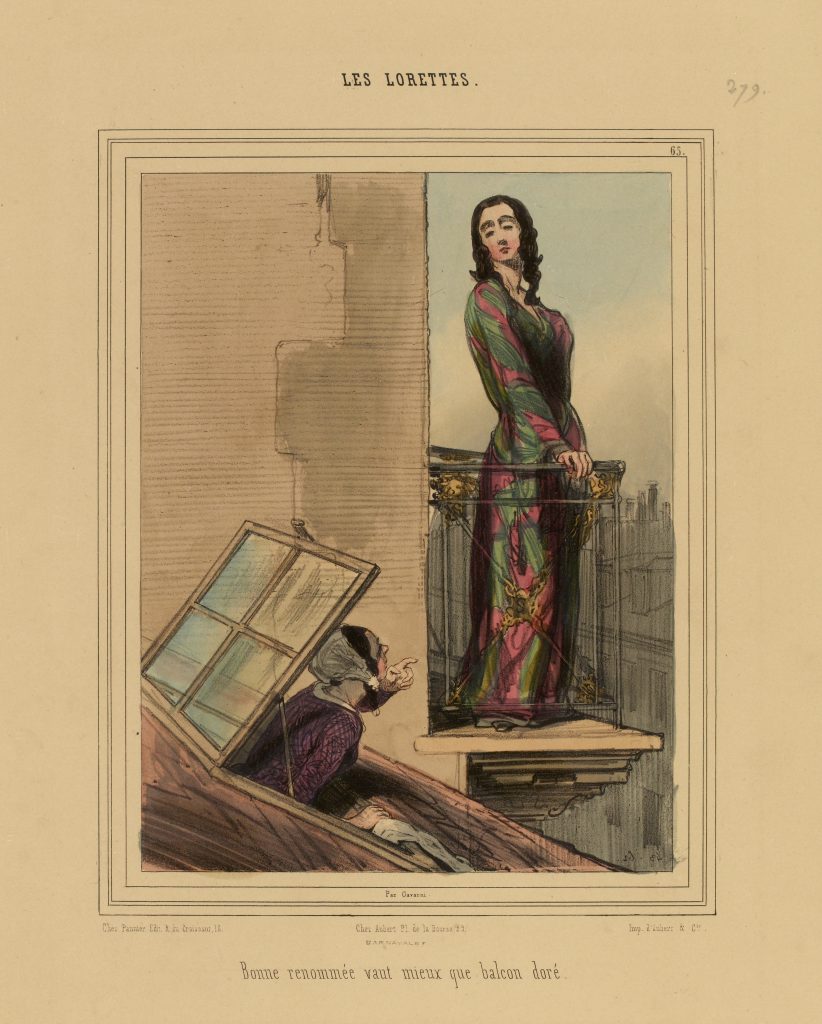
In the years around 1830, the district between Saint-Lazare and Montmartre was rapidly built up. In the barely completed apartment houses lived kept women, lorettes, were living who literally wiped down the plaster in these new buildings and gave an appearance of life to these properties without tenants. Balzac described the phenomenon precisely in his novel Béatrix.
‘Without the Aspasias of the Notre-Dame de Lorette quarter, far fewer houses would be built in Paris. On they go, pioneers of fresh stucco, towed by Speculation to the heights of Montmartre, planting the pegs for their tents, no pun intended, in the lonely wasteland of carved stone blocks, the likes of which adorn European streets from Amsterdam, Milan or Stockholm to London and Moscow, architectural steppes where the wind rustles innumerable flyers that betray the gaping void in the words, Apartments to let! The standing of these women is determined by their position within the apocryphal quarter. If her home be near the line traced by the Rue de Provence, the lady has an income, her budget is healthy; but should it stray toward the farther line of the Grands Boulevards or off towards the frightful town of Batignolles, she is without resources.’
Honoré de Balzac, Béatrix, 1839.
Unlike high-class courtesans, the Lorettes often had several protectors spread over the days of the week. Attitudes toward these sex workers was ambivalent: their youth and beauty were seductive, but they were scorned as immature, improvident and lazy. The caricaturist Gavarni made them one of his favourite subjects of ridicule in the 1840s.

The Lorette is decently housed in a modern apartment with a balcony on one of the middle floors of the building. From the open dormer of a lower house, a worker seems to be reproaching her for lack of virtue.

The Lorette was above all a kept woman, often by several men. Unlike prostitutes, she was not paid immediately but left her bills for her protectors. In this way, the men paying the rent, furniture or drinks, felt themselves to be a little bit at home.

This print includes almost all the stereotypes of the Lorette, a creature of indolence wallowing on a sofa while she waits for her lovers and chatting with one of her ilk. She brings out the main defects imputed to these women: vulgarity, futility and idleness. The painting hanging on the wall reminds us the Lorette gave herself over to sexual indulgence, something which the period severely condemned.

These girls had several lovers, in whom writers distinguished wealthy protectors, for preference enough of them to avoid the nuisance that would be caused by a break up, and a lover of the heart. Gavarni amuses himself here to show the meeting between a wealthy client with an ‘Arthur’, who doesn’t have the money to be jealous, and gracefully cedes his place to his richer, older rival, moderately pleased to run across the young man.
‘She doesn’t pay the landlord; she doesn’t pay her dressmaker; she doesn’t pay the dairy maid; she doesn’t pay the porter who brings her water. She pays for her own underwear. Her hairdresser is paid for.
She has a chosen lover who does not pay her, but who pays the perfumer for her soaps and vinegar.
[…] She does not like to dine, because it is tiring. She dines because that is her condition. She does not like to be caressed, because it wrinkles her dress. She does not wish to drink, because that could lead to delivery before payment.
She makes love to earn a life of leisure.
The Lorette eats like a regiment. She is stupid. She has all the impertinence of stupidity.
[…] Certain Lorettes are said to be entertaining. Those would be the ones who break glasses at dessert, crack ice in hot wine, sing Béranger for the waiter or do splits.
There are even a few with consumption that threaten to die on you.
None of them have any wit, or courage, or heart, or mettle. All have the same god: the god of a Half Crown.’
Edmond and Jules de Goncourt, La Lorette, 1853
Lorette: From the name of the Parisian church, Notre-Dame-de-Lorette, near the apartments where many of these women lived. In the 19th century, an elegant young woman of easy virtue. (Dictionnaire de l’Académie française, 9th edition)